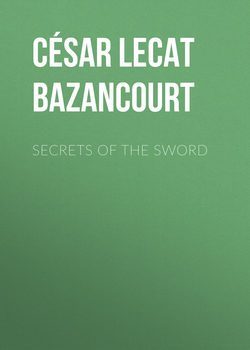Читать книгу Secrets of the Sword - César Lecat de Bazancourt - Страница 5
The First Evening
III
Оглавление“We are told to draw a hard and fast line between two schools, – probably for the convenience of putting ourselves in the right and our opponents in the wrong.
“For my own part, and speaking seriously, I fail to recognise more than one. True, that one may be regarded from several points of view. I can distinguish three very clearly, but these different aspects are very far from being distinct in the sense of clearly defined natural orders. I will describe three kinds of play, which are adopted by fencers according to fancy.
“The first is fencing regarded as a graceful athletic exercise, contrived very much on the lines of a ceremonious dance, the interlacing movements of the combatants, as they close and fall back to their original positions, recalling the figures of a quadrille. One might almost say that the simplest example of this method is the single combat of melodrama, the stage duel with its concerted movements, and that it finds its most perfect expression, or, if you prefer the phrase, attains its object in the execution of a series of voltes and passes or dodgy side-steps, a complicated succession of attacks, parries, and ripostes, skilfully delivered, and brought off strictly in accordance with prescribed regulations.
“The second is fencing conceived as an exact science. Here it is ‘the noble art’ that calls for profound study and arduous research. The student must explore its truths and consider them in all their bearings, pursue theory to its remotest ramifications, and drag to light its most reluctant secrets. Solid hard work and assiduous application, such as science always demands of her votaries, backed by physical and intellectual resources naturally fitted to the task, are the only means which will enable you to achieve this consummate skill, the highest degree of attainment in the art. You will not be surprised when I say that the annals of the sword record but few names of undisputed preeminence, new stars that mark the epochs in its history.
“The third is fencing considered from the point of view of practical self-defence. In this case the method is fashioned, so to speak, by personal inspiration, and is impressed with the stamp of individual character. This is the real thing, battle in deadly earnest, complete with all the terrors and sudden crises of warfare. Instead of passes ingeniously complicated, and foiled by parries as scientifically elaborate, steel clashes with steel, intent on forcing somewhere a passage for the point. The game becomes a fight, and a fight all the more grim, because the fighting animal is reinforced by science, and chooses from her armoury the weapons that make him strong, rejecting whatever is cumbrous or likely to obscure his ‘native hue of resolution.’
“We now see the difference between the two styles, – call them schools if you like. One wishes to preserve intact and unalloyed the ancient academical traditions, – I had almost called them the traditions of the dancing master, – while the other inclines to what nowadays we call realism. Is that a gain or a loss? At the present time everything tends to realism, but we are not, so far as I know, obliged to admit that the dream is the type of perfect beauty, and the real the type of all that is ugly and bad. We live in a practical age, perhaps too practical. Sometimes one may regret that it is so; but what other result could you expect to follow from the convulsions that have so frequently shattered it? The ideal, scared by the noise and confusion of our revolutions, so often repeated, so seldom foreseen, has used its wings to some purpose, and taken flight to a world far removed from ours.
